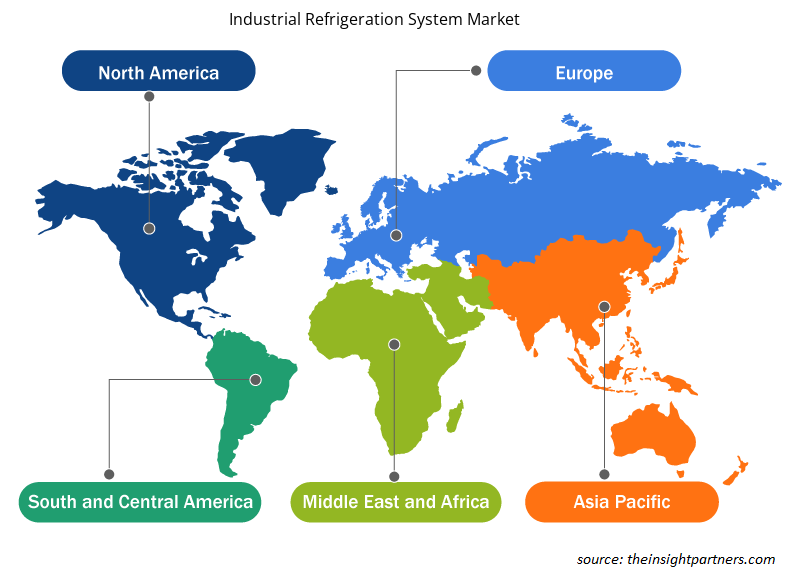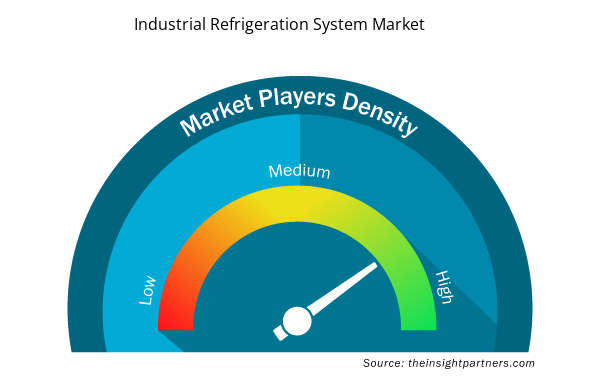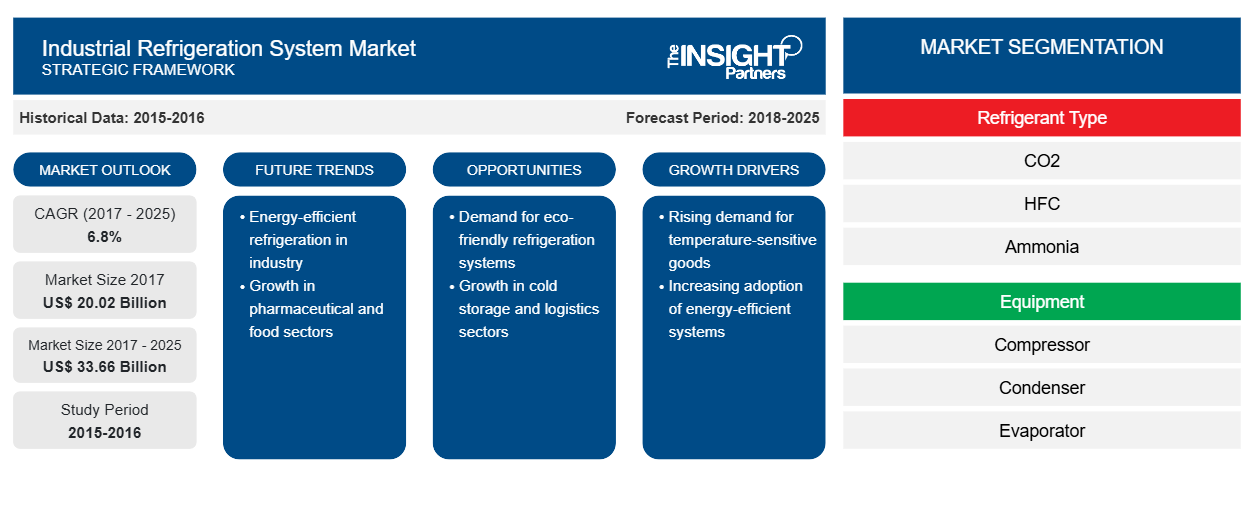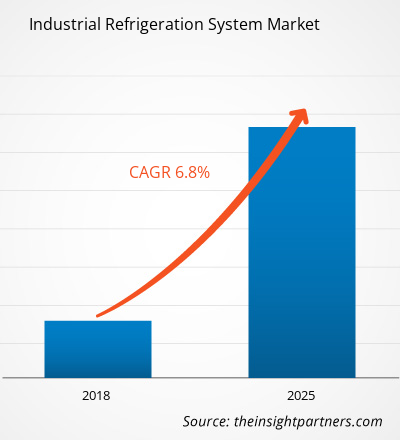産業用冷凍システム市場は2017年に200.2億米ドルと評価され、2025年までに336.6億米ドルに達すると予測されています。また、2018年から2025年にかけて6.8%のCAGRで成長すると予想されています。
食品加工・保管、化学薬品・医薬品、石油・ガス、輸送業界などの業界における冷媒システムの重要性は、長年にわたって世界的に高まっています。これにより、メーカーは継続的に革新を起こし、技術的に高度な冷凍システムを設計し、エンドユーザーに大きな影響を与えています。冷媒の分野での革新により、HFCからアンモニア、アンモニアからCO2、そして再びアンモニア(NH3)とCO2のカスケードなど、いくつかの代替品やアップグレードが見られました。HFCはかつて最も有名な冷媒でしたが、高いODP(オゾン層破壊係数)と高いGWP(地球温暖化係数)などの欠点、非常に可燃性があり毒性があるため、メーカーは冷媒をアンモニア(NH3)に置き換えざるを得ませんでした。アンモニアを使用した冷凍システムは、自然発生的で環境に優しいガスであること、極めて優れた熱力学的特性があること、熱伝達面積が最小限で済むため製造業者がパイプラインを小さくできることなど、3 つの際立った利点により市場でかなりの人気を得ています。さらに、NH3 ガスは従来の HFC 冷媒よりも 15% - 20% 効率的です。ただし、ガスの吸湿性により、ガスは簡単に蒸発して環境に移動し、その毒性により周囲の人間や機械に危険な結果をもたらします。アンモニア蒸気のもう 1 つの欠点は、機械の潤滑油で汚染された場合に可燃性になることです。現在の状況では、産業用冷凍システムのメーカーは、冷媒として二酸化炭素 CO2 を個別に使用しているほか、CO2 と NH3 をカスケード接続しています。 CO2 は入手しやすく、他の物質に比べてはるかに安価であるため、メーカーは最終製品の初期費用を削減し、システムの運用効率を高めることができます。さらに、CO2 と NH3 のカスケードは冷却効率がはるかに高く、大量のエネルギーを節約できるため、エンド ユーザーの運用コストを削減できます。これらの傾向は、世界中の産業用冷却システム メーカーの間で見られており、現在システムの成長に大きな影響を与えています。
研究センターは、機械の技術性を高め、環境への危険性を減らすために、新しい技術を継続的に革新し、従来の冷媒の置き換えを研究しているため、産業用冷凍システム市場の将来は有望です。その結果、技術的に強化されたセンサーシステムが開発され、統合され、今後数年間で多くの産業を引き付けることが期待されています。
要件に合わせてレポートをカスタマイズする
このレポートの一部、国レベルの分析、Excelデータパックなど、あらゆるレポートを無料でカスタマイズできます。また、スタートアップや大学向けのお得なオファーや割引もご利用いただけます。
- このレポートの主要な市場動向を入手してください。この無料サンプルには、市場動向から見積もりや予測に至るまでのデータ分析が含まれます。
市場洞察 - 産業用冷凍システム市場
包装食品の保管能力に対する需要の高まり
近年、包装食品の消費傾向は世界的に大幅に増加しており、北米とアジア太平洋地域では特に顕著です。米国では、包装食品や冷凍食品の消費量が過去 10 年間で 50% 増加しました。北米諸国の消費者は、ライフスタイルの変化、消費の利便性、健康意識をより重視しています。これらの要因により、世界中で包装食品の需要が促進されています。北米地域では、塩味製品、乳製品、菓子製品、その他の製品の消費が急増したため、近年、包装食品業界が好調です。包装食品の需要を促進しているもう 1 つの食品は肉です。米国食品医薬品局 (FDA) は、連邦食品・医薬品・化粧品法 (FFDCA) に基づき、これらの食品包装会社と緊密に連携して、最高品質の包装を提供しています。FDA はまた、包装から不衛生または不健康な物質を排除するためのいくつかの規則を実施しています。米国政府の許可のおかげで、この地域では包装食品の調達が増加しています。包装食品の消費量も、この地域の小売店や百貨店の大幅な増加に伴って、最近増加しています。包装食品の消費量の増加傾向により、この地域では定評のある企業に加えて、いくつかの企業が台頭しています。この地域の食品包装会社の成長は、同時に産業用冷蔵庫の成長を目撃することにつながっています。これは、これらの産業用冷蔵庫が広範囲にわたる温度を維持できるという事実によるものです。温度変化に加えて、これらの産業用冷蔵庫は、揮発性またはカスケード形式のアンモニアと CO2 を冷却剤または冷媒として使用します。これはエネルギー効率が良く、組み合わせにより、食品生産だけでなく、食品の包装および保管エリアの安全性が向上します。さらに、これらの包装食品は、包装の鮮度を維持する目的で、より長い期間冷蔵室に保管されるため、それぞれの食品に望ましい温度を維持するためにも産業用冷蔵庫が必要です。したがって、パッケージ化された処理とパッケージング、および保管能力は、現在の状況において産業用冷蔵庫市場の成長を引き起こす主な要因です。
冷媒タイプセグメントの分析
冷媒の種類に基づいて、産業用冷凍システム市場は CO2、HFC、アンモニアに分類されます。地球温暖化と環境条件の変化、および関連する統治機関の規制は、産業用冷凍システム市場の機能に重要な役割を果たします。冷媒の選択は、世界中のさまざまなコンプライアンス要求により、長年にわたって採用において徐々に変化してきました。アンモニアと炭化水素は、数年前までこの業界で使用されていた最初の冷媒でした。
機器セグメントの洞察
機器に基づいて、産業用冷凍システム市場は、コンプレッサー、コンデンサー、蒸発器、その他に分かれています。産業用冷凍システム市場は、円滑な機能に不可欠な重要なコンポーネントで構成されています。コンプレッサー、コンデンサー、蒸発器、およびその他の小型コンポーネントが産業用冷凍システムを構成しています。
アプリケーションセグメントの洞察
用途に基づいて、産業用冷凍システム市場は、食品加工、化学薬品および医薬品、冷蔵物流に分かれています。食品加工業界は、北米の一般大衆の間で冷凍食品、冷蔵肉、菓子、醸造所、液体ミルク加工の需要が急増したことから、2017年にこの地域で最大の収益シェアを占めました。米国は、包装食品と冷凍食品の最大の消費国の一つであり、ヨーロッパの先進国がそれに続きます。また、中東やアジア太平洋地域の発展途上国など、世界の他の地域でも、包装食品と食品製品の需要に変化のパターンが見られます。
市場プレーヤーは、競合他社と競争するために、自社製品に高度なテクノロジーと機能を統合することにより、新製品の革新と開発に重点を置いています。
2018年:GEAグループは、研究、開発、イノベーションへの支出を賄うために、欧州投資銀行(EIB)と2025年までの1億5,000万ユーロの融資契約を締結しました。
2018 年: Carnot Refrigeration は Emergent Cold Technologies と販売契約を締結しました。この契約に基づき、Emergent Cold は Carnot Refrigeration の CO2 システムを米国の複数の地域に存在する顧客に提供します。
2017年:EVAPCO社は1,500万米ドルを投資してタニータウンの製造施設を拡張する計画を発表しました。
産業用冷凍システム市場の地域別分析
予測期間を通じて産業用冷凍システム市場に影響を与える地域的な傾向と要因は、Insight Partners のアナリストによって徹底的に説明されています。このセクションでは、北米、ヨーロッパ、アジア太平洋、中東、アフリカ、南米、中米にわたる産業用冷凍システム市場のセグメントと地理についても説明します。

- 産業用冷凍システム市場の地域別データを入手
産業用冷凍システム市場レポートの範囲
| レポート属性 | 詳細 |
|---|---|
| 2017年の市場規模 | 200.2億米ドル |
| 2025年までの市場規模 | 336.6億米ドル |
| 世界のCAGR(2017年 - 2025年) | 6.8% |
| 履歴データ | 2015-2016 |
| 予測期間 | 2018-2025 |
| 対象セグメント | 冷媒の種類別
|
| 対象地域と国 | 北米
|
| 市場リーダーと主要企業プロフィール |
|
産業用冷凍システム市場のプレーヤー密度:ビジネスダイナミクスへの影響を理解する
産業用冷凍システム市場は、消費者の嗜好の変化、技術の進歩、製品の利点に対する認識の高まりなどの要因により、エンドユーザーの需要が高まり、急速に成長しています。需要が高まるにつれて、企業は提供を拡大し、消費者のニーズを満たすために革新し、新たなトレンドを活用し、市場の成長をさらに促進しています。
市場プレーヤー密度とは、特定の市場または業界内で活動している企業または会社の分布を指します。これは、特定の市場スペースに、その規模または総市場価値と比較して、どれだけの競合相手 (市場プレーヤー) が存在するかを示します。
産業用冷凍システム市場で事業を展開している主要企業は次のとおりです。
- カルノー冷凍
- エマーソンエレクトリック社
- ユナイテッドテクノロジーズコーポレーション
- イノベーティブ冷凍システムズ株式会社
- ジョンソンコントロールズインターナショナル株式会社
免責事項:上記の企業は、特定の順序でランク付けされていません。

- 産業用冷凍システム市場のトップキープレーヤーの概要を入手
産業用冷凍システム市場 – 冷媒タイプ別
- 二酸化炭素
- HFC
- アンモニア(NH3)
産業用冷凍システム市場 – 機器別
- コンプレッサー
- コンデンサー
- 蒸発器
- その他
産業用冷凍システム市場 – 用途別
- 食品加工
- 化学薬品・医薬品
- 石油・ガス
- 冷蔵物流
産業用冷凍システム市場 – 地域別
北米
- 私たち
- カナダ
- メキシコ
ヨーロッパ
- フランス
- ドイツ
- イタリア
- 英国
- ロシア
- その他のヨーロッパ
アジア太平洋(APAC)
- 中国
- インド
- 韓国
- 日本
- その他のアジア太平洋地域
中東・アフリカ(MEA)
- 南アフリカ
- MEAの残り
南アメリカ(SAM)
- ブラジル
- アルゼンチン
- 残りのSAM
産業用冷凍システム市場 – 企業プロファイル
- カルノー冷凍
- エマーソンエレクトリック社
- ユナイテッドテクノロジーズコーポレーション
- イノベーティブ冷凍システムズ株式会社
- ジョンソンコントロールズインターナショナル株式会社
- インガソル・ランドPLC
- エバプコ株式会社
- GEAグループAG
- ハスマン株式会社
- ドーバーコーポレーション
- 過去2年間の分析、基準年、CAGRによる予測(7年間)
- PEST分析とSWOT分析
- 市場規模価値/数量 - 世界、地域、国
- 業界と競争環境
- Excel データセット



Report Coverage
Revenue forecast, Company Analysis, Industry landscape, Growth factors, and Trends

Segment Covered
This text is related
to segments covered.

Regional Scope
North America, Europe, Asia Pacific, Middle East & Africa, South & Central America

Country Scope
This text is related
to country scope.
Trends and growth analysis reports related to Electronics and Semiconductor : READ MORE..
The List of Companies
1. Carnot Refrigeration
2. Emerson Electric Co.
3. United Technologies Corporation
4. Innovative Refrigeration Systems, Inc.
5. Johnson Controls, International Plc.
6. Ingersoll-Rand PLC
7. Evapco, Inc.
8. GEA Group AG
9. Hussmann Corporation
10. Dover Corporation
The Insight Partners performs research in 4 major stages: Data Collection & Secondary Research, Primary Research, Data Analysis and Data Triangulation & Final Review.
- Data Collection and Secondary Research:
As a market research and consulting firm operating from a decade, we have published and advised several client across the globe. First step for any study will start with an assessment of currently available data and insights from existing reports. Further, historical and current market information is collected from Investor Presentations, Annual Reports, SEC Filings, etc., and other information related to company’s performance and market positioning are gathered from Paid Databases (Factiva, Hoovers, and Reuters) and various other publications available in public domain.
Several associations trade associates, technical forums, institutes, societies and organization are accessed to gain technical as well as market related insights through their publications such as research papers, blogs and press releases related to the studies are referred to get cues about the market. Further, white papers, journals, magazines, and other news articles published in last 3 years are scrutinized and analyzed to understand the current market trends.
- Primary Research:
The primarily interview analysis comprise of data obtained from industry participants interview and answers to survey questions gathered by in-house primary team.
For primary research, interviews are conducted with industry experts/CEOs/Marketing Managers/VPs/Subject Matter Experts from both demand and supply side to get a 360-degree view of the market. The primary team conducts several interviews based on the complexity of the markets to understand the various market trends and dynamics which makes research more credible and precise.
A typical research interview fulfils the following functions:
- Provides first-hand information on the market size, market trends, growth trends, competitive landscape, and outlook
- Validates and strengthens in-house secondary research findings
- Develops the analysis team’s expertise and market understanding
Primary research involves email interactions and telephone interviews for each market, category, segment, and sub-segment across geographies. The participants who typically take part in such a process include, but are not limited to:
- Industry participants: VPs, business development managers, market intelligence managers and national sales managers
- Outside experts: Valuation experts, research analysts and key opinion leaders specializing in the electronics and semiconductor industry.
Below is the breakup of our primary respondents by company, designation, and region:

Once we receive the confirmation from primary research sources or primary respondents, we finalize the base year market estimation and forecast the data as per the macroeconomic and microeconomic factors assessed during data collection.
- Data Analysis:
Once data is validated through both secondary as well as primary respondents, we finalize the market estimations by hypothesis formulation and factor analysis at regional and country level.
- Macro-Economic Factor Analysis:
We analyse macroeconomic indicators such the gross domestic product (GDP), increase in the demand for goods and services across industries, technological advancement, regional economic growth, governmental policies, the influence of COVID-19, PEST analysis, and other aspects. This analysis aids in setting benchmarks for various nations/regions and approximating market splits. Additionally, the general trend of the aforementioned components aid in determining the market's development possibilities.
- Country Level Data:
Various factors that are especially aligned to the country are taken into account to determine the market size for a certain area and country, including the presence of vendors, such as headquarters and offices, the country's GDP, demand patterns, and industry growth. To comprehend the market dynamics for the nation, a number of growth variables, inhibitors, application areas, and current market trends are researched. The aforementioned elements aid in determining the country's overall market's growth potential.
- Company Profile:
The “Table of Contents” is formulated by listing and analyzing more than 25 - 30 companies operating in the market ecosystem across geographies. However, we profile only 10 companies as a standard practice in our syndicate reports. These 10 companies comprise leading, emerging, and regional players. Nonetheless, our analysis is not restricted to the 10 listed companies, we also analyze other companies present in the market to develop a holistic view and understand the prevailing trends. The “Company Profiles” section in the report covers key facts, business description, products & services, financial information, SWOT analysis, and key developments. The financial information presented is extracted from the annual reports and official documents of the publicly listed companies. Upon collecting the information for the sections of respective companies, we verify them via various primary sources and then compile the data in respective company profiles. The company level information helps us in deriving the base number as well as in forecasting the market size.
- Developing Base Number:
Aggregation of sales statistics (2020-2022) and macro-economic factor, and other secondary and primary research insights are utilized to arrive at base number and related market shares for 2022. The data gaps are identified in this step and relevant market data is analyzed, collected from paid primary interviews or databases. On finalizing the base year market size, forecasts are developed on the basis of macro-economic, industry and market growth factors and company level analysis.
- Data Triangulation and Final Review:
The market findings and base year market size calculations are validated from supply as well as demand side. Demand side validations are based on macro-economic factor analysis and benchmarks for respective regions and countries. In case of supply side validations, revenues of major companies are estimated (in case not available) based on industry benchmark, approximate number of employees, product portfolio, and primary interviews revenues are gathered. Further revenue from target product/service segment is assessed to avoid overshooting of market statistics. In case of heavy deviations between supply and demand side values, all thes steps are repeated to achieve synchronization.
We follow an iterative model, wherein we share our research findings with Subject Matter Experts (SME’s) and Key Opinion Leaders (KOLs) until consensus view of the market is not formulated – this model negates any drastic deviation in the opinions of experts. Only validated and universally acceptable research findings are quoted in our reports.
We have important check points that we use to validate our research findings – which we call – data triangulation, where we validate the information, we generate from secondary sources with primary interviews and then we re-validate with our internal data bases and Subject matter experts. This comprehensive model enables us to deliver high quality, reliable data in shortest possible time.


 このレポートの無料サンプルを入手する
このレポートの無料サンプルを入手する